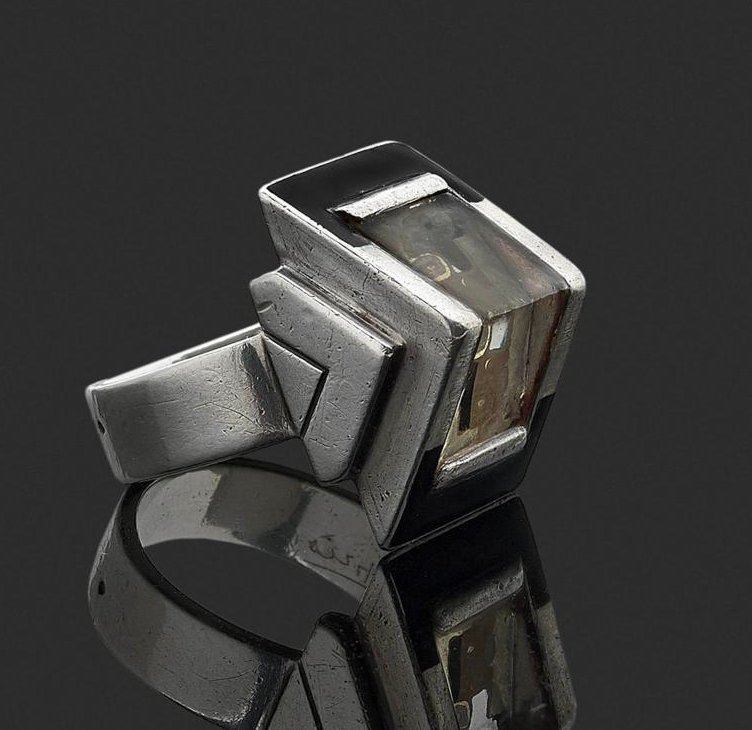Jean Després, figure of the modern jewellery history
Born in 1889, Jean Desprès went through various periods during his long life which shaped his artistic personality. Surprising as it may seen, he wasn’t born from a jewelry family and would complete his apprenticeship alongside a goldsmith. This training would later bear a strong influence on his work as his pieces are clearly resorting to goldsmithing techniques.
Jean Desprès
© D.R.
Another strong source of influence for Jean Desprès would be America and more precisely Mexico as in 1930s several Mexican artists escaped the political turmoil in their country and flee to Paris. Desprès would become friend with some of them and quickly be fascinated by their mysterious civilization.
Jean Després
Silver bangle bracelet
Hammered silver with raised rectangular bands
Signed J. Després with maker's mark
© RAGO Arts
The 1920s, often nicknamed the “roaring twenties”, would mark the beginnings of Jean Desprès as a jewelry designer and maker. At this time Paris was regaining its leading position as the Art world capital and several new artistic movements were emerging in Europe such as Fauvism, Cubism, Bauhaus in Germany and so on…
This strong emulation would bear a strong influence on the creations of Jean Desprès and the young jewelry designer would start building relationships with some artistic figures of this period such as Braque, Signac, Jouve, Mayodon, Pompon or Durand.
In 1925 Jean Desprès participated to the International decorative Arts exhibit in Paris where a new style, later named Art Deco, would succeed.
Jean Després
Silver and gold ring
Designed with applied panels of abstract silver and circular gold
With maker’s mark for Jean Després
© RAGO Arts
This new movement - defined by a strong relationship between the lines and volumes of materials - would also deeply mark the jewelry world. From this influence, powerful, original and geometric jewelry designs were born where the harmony and purity of the lines surpass the attention given to the materials. The prominent figures who participated to the development of this new movement include the notorious Georges and Jean Fouquet and Raymond Templier.
In the 1930s Jean Desprès reached full mastery of his art but the Second World War marked the beginning of difficult times and scarcity of the materials necessary for jewelry making. Jean Desprès would however be less impacted than other jewelry makers as his pieces remained affordable thanks to the use of less expensive materials such as silver.
Jean Desprès
Chalcedony and silver necklace, 1931
© Bonhams
However once the war was over, Desprès could rely on the strong support of his loyal customers to bounce back and would start participating to international exhibitions.
His avant-garde pieces break up with the tradition by not relying on the size of the stones or the value of the materials used. Jean Desprès viewed his creations as modern and powerful objects inspired by mechanism rejecting any useless and superfluous elements. In the 1920s during his first exhibitions, his work would surprise and sometimes be rejected by the public who considered it to be to modern at that time.
Etienne Cournault & Jean Desprès
Exceptional modernist ring with silver and black lacquer setting, painted and engraved glass cabochon.
circa 1930
© Ader
In the 1930s, Jean Desprès would collaborate with the artist Etienne Cournault, known for his paintings on glass panels resulting in unusual color and lighting effects. The jewelry maker would produce the mount while Cournault would ornament it with small painted glass panels in black and grey shades.
In 1930 Jean Desprès would unveil a new collection nicknamed “engine jewelry” strongly strongly inspired by plane engines which he would exhibit during the “aeronautics and arts” exhibition.
Jean Desprès
Man’s ring, "bijoux moteurs" collectionIn silver, the circular flanged plate stylizing an aircraft engine
Circa 1930
© Artcurial
In the 1950s he would stay true to his original design and would resort to “softer” lines in his designs to fit with the jewelry trend of this time. He would continue to produce pieces for his clientele until his death in 1980.







